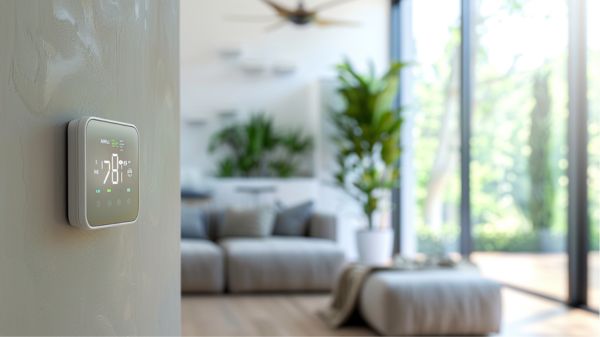In today’s economic climate, businesses are increasingly seeking ways to reduce overhead costs without sacrificing functionality or employee comfort. One area ripe for such optimization is office lighting. By converting to LED technology, companies can greatly decrease their energy consumption and enhance the longevity of their lighting systems, thereby reducing both operational costs and environmental impact. However, despite these apparent benefits, the adoption of cost-effective lighting solutions for offices like LEDs involves certain challenges and considerations.
What are these potential obstacles, and how can businesses effectively navigate them to reap the considerable rewards of modern lighting technology? Let’s explore.
Key Takeaways
- LED lighting significantly reduces energy bills by consuming up to 70% less energy.
- Long-lasting LEDs decrease maintenance costs with a lifespan of up to 50,000 hours.
- Financial incentives from energy companies can offset the initial cost of LED installation.
- LEDs help reduce carbon footprints, promoting a more sustainable office environment.
- High-quality LED fixtures improve lighting quality, enhancing workplace comfort and productivity.
Overview of LED Technology
In the domain of office lighting, LED technology stands out as a superior choice due to its exceptional energy efficiency and longevity. Utilizing advanced semiconductor materials, LED technology efficiently converts electricity into light, achieving an energy efficiency rate of about 80%. This starkly contrasts with traditional incandescent bulbs, which operate at a mere 20% efficiency. The benefits of this are twofold: markedly reduced energy consumption and significant cost savings on utilities.
Moreover, LEDs boast a remarkably longer lifespan, capable of lasting up to 50,000 hours compared to the approximately 1,000 hours for conventional bulbs. This extended lifespan not only cuts down the frequency of replacements but also contributes to a reduction in maintenance and operational costs over time.
Additionally, by producing minimal heat, LED lighting helps to lower cooling expenses in office environments, further optimizing energy use. LED lighting also aligns well with sustainable practices by reducing the environmental impact and enhancing energy efficiency in buildings.
Importantly, the eco-friendly nature of LED lighting solutions is underscored by their lack of toxic materials, such as mercury, making them a safer choice for both the environment and workplace.
The widespread adoption of LED lighting in offices is a reflection of its ability to harmonize energy-saving goals with effective, long-term lighting solutions, all while helping businesses reduce their carbon footprint.
Benefits of LED Lighting
Building on the robust foundation provided by LED technology, the benefits of LED lighting in office environments are numerous and impactful. One of the most noteworthy advantages is the substantial energy savings they offer. LED lighting consumes up to 70% less energy than traditional incandescent bulbs, which translates into considerably lower electricity bills, making it a cost-effective solution in the long term.
Additionally, the long lifespan of LED bulbs, which can reach up to 50,000 hours, drastically reduces the frequency of replacements. This not only lowers maintenance costs but also diminishes the operational disruptions typically associated with replacing lighting fixtures. By integrating energy-efficient appliances like LED lights, businesses can further enhance their sustainable practices.
Here are three key benefits of LED lighting:
- Energy Efficiency: LEDs convert about 80% of electrical energy into light, ensuring more light per watt and less waste.
- Reduced Carbon Footprint: By greatly decreasing energy consumption, LEDs help reduce carbon emissions, promoting a greener office environment.
- Rebates and Incentives: Many energy companies provide financial incentives for offices upgrading to LED fixtures, further enhancing the cost-effectiveness of this lighting option.
Incorporating LED lighting is not just an operational decision but a strategic move towards sustainability and economic efficiency.
Challenges in Implementing LEDs
Despite their many benefits, implementing LED lighting in office settings presents several challenges that can deter businesses from changing.
The cost of upgrading to energy-efficient lighting, particularly the initial investment, is considerably higher compared to traditional lighting options. This financial barrier can be especially intimidating for smaller firms or those with tight budgets, making the shift appear less feasible despite the promise of long-term savings.
Additionally, older office buildings often have existing fixtures designed for different lighting technologies, leading to compatibility issues. Retrofitting these fixtures or replacing them entirely adds further costs and complexity.
Furthermore, without a meticulously planned redesign, introducing LEDs might result in over-illumination. This excess brightness not only creates a harsh working environment but also negates some of the energy savings LEDs are known for.
Moreover, achieving the right lighting quality involves more than simply swapping out bulbs. It requires careful attention to color temperature and brightness to guarantee a comfortable and productive workspace. Ensuring even light distribution to avoid shadows and dark spots also poses a challenge, demanding expert knowledge in lighting design to fully harness the benefits of LEDs in office environments.
Implementing smart lighting options can address these challenges by allowing for adjustable settings and better control over illumination levels.
Strategies for LED Transition
To effectively shift to LED lighting in office spaces, it is essential to conduct a thorough assessment of the current lighting infrastructure. This initial step is vital for tailoring the LED shift plan to the specific needs of the facility, thereby ensuring that the new lighting system maximizes energy efficiency and reduces operational costs.
When upgrading your office lighting to LED, consider these practical strategies:
- Select High-Quality LED Fixtures: Opt for commercial-grade LEDs that offer durability and superior performance. This choice helps in reducing maintenance costs and frequency of replacements, contributing to overall lower energy consumption.
- Integrate Smart Lighting Controls: Implement dimming systems and smart controls to adjust lighting levels appropriately throughout the day or in response to different office activities. This flexibility not only enhances worker comfort but also contributes to energy savings.
- Ensure System Compatibility: Check that the new LED fixtures are compatible with existing electrical infrastructure to avoid unnecessary complications and expenses during installation. Incorporating advanced battery technology can further enhance the efficiency and lifecycle of LED systems, similar to improvements seen in hybrid vehicles.
Engaging expert consultants in commercial lighting can provide additional insights and customized solutions, further optimizing the shift process and ensuring that your investment in LED technology pays off through significant energy savings and improved lighting quality.
Environmental Impact of LEDs
The environmental advantages of shifting to LED lighting in office spaces are substantial and multifaceted. Primarily, LED office lighting dramatically reduces the carbon footprint of a facility. By implementing LEDs, offices can cut their greenhouse gas emissions by up to one-third compared to traditional lighting methods, contributing greatly to global efforts against climate change.
The energy efficiency of LEDs, which can reach approximately 80%, translates directly into lower electricity consumption. This not only reduces the strain on power generation systems but also minimizes the environmental impact associated with energy production.
Additionally, unlike Compact Fluorescent Lamps (CFLs), LEDs do not contain toxic mercury. This absence of hazardous materials makes LEDs a safer choice for the workplace and the environment, mitigating the risk associated with disposal and handling of toxic substances.
Moreover, LEDs are 100% recyclable. Their production from non-toxic materials complements a sustainable office environment, supporting waste reduction goals and decreasing the volume of harmful substances entering landfills.
These multifactorial benefits underscore the pivotal role that LED lighting can play in promoting environmental stewardship while maintaining workplace efficiency and safety.
Calculating Cost Savings
Recognizing the economic benefits of LED lighting, businesses are increasingly turning to this technology not only for its environmental advantages but also for substantial cost savings.
The change from traditional bulbs to LED lights is a strategic decision that reduces both energy costs and maintenance costs. By analyzing the direct financial gains alongside long-term operational efficiencies, companies can better understand the true value of investing in LEDs.
- Energy Cost Reduction: Upgrading to LED lighting can decrease energy expenses by up to 70%, a significant saving when considering the extended hours of operation in office environments.
- Maintenance Savings: With a lifespan of approximately 50,000 hours, LEDs minimize the frequency of replacements needed compared to traditional bulbs, thereby cutting down on maintenance costs.
- Rebates and Incentives: Many energy companies offer financial incentives for businesses that install LED lights, helping to offset the initial costs and accelerate the return on investment.
These points demonstrate not just the cost-efficiency of LEDs but also their role in a financially sustainable business strategy.
Case Studies on LED Efficiency
Several case studies vividly illustrate the efficacy of LED lighting in both economic and environmental contexts. For instance, a Michigan office building changed from fluorescent to LED lighting and witnessed an impressive 115% increase in annual return on investment. This not only emphasizes LED efficiency but also showcases considerable financial benefits.
Similarly, Los Angeles reported over $5 million in annual savings after upgrading its street lights to LEDs, underscoring the potential for considerable cost savings through strategic LED implementation.
Furthermore, LEDs are renowned for their reduced energy consumption, consuming up to 70% less energy than traditional lighting sources. This shift directly correlates with lower electricity bills, enhancing the financial viability of LEDs in an office environment.
Additionally, the environmental efficiency of LED lighting is equally notable. By replacing 30 incandescent bulbs with LEDs, businesses can slash their CO2 emissions from 2500 kg annually to just 200 kg, greatly mitigating their environmental impact.
Moreover, the long lifespan of LEDs, which can extend up to 50,000 hours, drastically cuts down maintenance costs compared to the 1,000 hours typical of incandescent bulbs. This durability further reinforces the practicality and cost-effectiveness of adopting LED lighting solutions in modern office settings.
Future Trends in Office Lighting
As office environments evolve, so too does the approach to lighting, with emerging trends notably enhancing both aesthetic appeal and functional efficiency. The integration of natural elements through biophilic design not only brings the outdoors in but also boosts employee productivity and wellness considerably.
Moreover, human-centric lighting systems, which adjust color temperatures to complement circadian rhythms, are proving essential in enhancing focus and reducing fatigue. Additionally, the implementation of smart technology facilitates precise control and automation, dramatically increasing energy efficiency in office settings.
These developments underscore a collective move towards more sustainable, efficient, and health-promoting office environments. Consider these key trends:
- Biophilic Design: Emphasizing the connection with nature, using elements like natural light and organic patterns to foster a tranquil and productive workspace.
- Smart Lighting Solutions: IoT-enabled fixtures that adjust automatically for ideal energy use and comfort, reducing costs and environmental impact.
- Human-Centric Lighting: Tailoring light settings to natural human rhythms, thereby supporting better mental and physical health in professional settings.
These innovations not only promise to revolutionize the way we think about office lighting but also align with broader goals of sustainability and employee well-being, making them essential considerations for future-ready office designs.
Related Post: Revolutionary LED Bulbs Outshine the Competition.
Conclusion
To summarize, the adoption of LED technology in office environments offers a compelling array of benefits, including substantial energy savings, lower maintenance costs, and a reduced environmental footprint.
Despite the challenges associated with shifting to LED lighting, strategic planning and implementation can mitigate these obstacles effectively.
The continual advancements in LED technology further underscore its role as a sustainable solution, promising not only immediate cost reductions but also long-term operational efficiencies and environmental stewardship.




